Jinghui Qin
AssoCiAm: A Benchmark for Evaluating Association Thinking while Circumventing Ambiguity
Sep 18, 2025Abstract:Recent advancements in multimodal large language models (MLLMs) have garnered significant attention, offering a promising pathway toward artificial general intelligence (AGI). Among the essential capabilities required for AGI, creativity has emerged as a critical trait for MLLMs, with association serving as its foundation. Association reflects a model' s ability to think creatively, making it vital to evaluate and understand. While several frameworks have been proposed to assess associative ability, they often overlook the inherent ambiguity in association tasks, which arises from the divergent nature of associations and undermines the reliability of evaluations. To address this issue, we decompose ambiguity into two types-internal ambiguity and external ambiguity-and introduce AssoCiAm, a benchmark designed to evaluate associative ability while circumventing the ambiguity through a hybrid computational method. We then conduct extensive experiments on MLLMs, revealing a strong positive correlation between cognition and association. Additionally, we observe that the presence of ambiguity in the evaluation process causes MLLMs' behavior to become more random-like. Finally, we validate the effectiveness of our method in ensuring more accurate and reliable evaluations. See Project Page for the data and codes.
Boundary-Driven Table-Filling with Cross-Granularity Contrastive Learning for Aspect Sentiment Triplet Extraction
Feb 04, 2025



Abstract:The Aspect Sentiment Triplet Extraction (ASTE) task aims to extract aspect terms, opinion terms, and their corresponding sentiment polarity from a given sentence. It remains one of the most prominent subtasks in fine-grained sentiment analysis. Most existing approaches frame triplet extraction as a 2D table-filling process in an end-to-end manner, focusing primarily on word-level interactions while often overlooking sentence-level representations. This limitation hampers the model's ability to capture global contextual information, particularly when dealing with multi-word aspect and opinion terms in complex sentences. To address these issues, we propose boundary-driven table-filling with cross-granularity contrastive learning (BTF-CCL) to enhance the semantic consistency between sentence-level representations and word-level representations. By constructing positive and negative sample pairs, the model is forced to learn the associations at both the sentence level and the word level. Additionally, a multi-scale, multi-granularity convolutional method is proposed to capture rich semantic information better. Our approach can capture sentence-level contextual information more effectively while maintaining sensitivity to local details. Experimental results show that the proposed method achieves state-of-the-art performance on public benchmarks according to the F1 score.
Adaptive Few-shot Prompting for Machine Translation with Pre-trained Language Models
Jan 03, 2025Abstract:Recently, Large language models (LLMs) with in-context learning have demonstrated remarkable potential in handling neural machine translation. However, existing evidence shows that LLMs are prompt-sensitive and it is sub-optimal to apply the fixed prompt to any input for downstream machine translation tasks. To address this issue, we propose an adaptive few-shot prompting (AFSP) framework to automatically select suitable translation demonstrations for various source input sentences to further elicit the translation capability of an LLM for better machine translation. First, we build a translation demonstration retrieval module based on LLM's embedding to retrieve top-k semantic-similar translation demonstrations from aligned parallel translation corpus. Rather than using other embedding models for semantic demonstration retrieval, we build a hybrid demonstration retrieval module based on the embedding layer of the deployed LLM to build better input representation for retrieving more semantic-related translation demonstrations. Then, to ensure better semantic consistency between source inputs and target outputs, we force the deployed LLM itself to generate multiple output candidates in the target language with the help of translation demonstrations and rerank these candidates. Besides, to better evaluate the effectiveness of our AFSP framework on the latest language and extend the research boundary of neural machine translation, we construct a high-quality diplomatic Chinese-English parallel dataset that consists of 5,528 parallel Chinese-English sentences. Finally, extensive experiments on the proposed diplomatic Chinese-English parallel dataset and the United Nations Parallel Corpus (Chinese-English part) show the effectiveness and superiority of our proposed AFSP.
Learning Semantic-Aware Representation in Visual-Language Models for Multi-Label Recognition with Partial Labels
Dec 14, 2024



Abstract:Multi-label recognition with partial labels (MLR-PL), in which only some labels are known while others are unknown for each image, is a practical task in computer vision, since collecting large-scale and complete multi-label datasets is difficult in real application scenarios. Recently, vision language models (e.g. CLIP) have demonstrated impressive transferability to downstream tasks in data limited or label limited settings. However, current CLIP-based methods suffer from semantic confusion in MLR task due to the lack of fine-grained information in the single global visual and textual representation for all categories. In this work, we address this problem by introducing a semantic decoupling module and a category-specific prompt optimization method in CLIP-based framework. Specifically, the semantic decoupling module following the visual encoder learns category-specific feature maps by utilizing the semantic-guided spatial attention mechanism. Moreover, the category-specific prompt optimization method is introduced to learn text representations aligned with category semantics. Therefore, the prediction of each category is independent, which alleviate the semantic confusion problem. Extensive experiments on Microsoft COCO 2014 and Pascal VOC 2007 datasets demonstrate that the proposed framework significantly outperforms current state-of-art methods with a simpler model structure. Additionally, visual analysis shows that our method effectively separates information from different categories and achieves better performance compared to CLIP-based baseline method.
Dynamic Correlation Learning and Regularization for Multi-Label Confidence Calibration
Jul 09, 2024Abstract:Modern visual recognition models often display overconfidence due to their reliance on complex deep neural networks and one-hot target supervision, resulting in unreliable confidence scores that necessitate calibration. While current confidence calibration techniques primarily address single-label scenarios, there is a lack of focus on more practical and generalizable multi-label contexts. This paper introduces the Multi-Label Confidence Calibration (MLCC) task, aiming to provide well-calibrated confidence scores in multi-label scenarios. Unlike single-label images, multi-label images contain multiple objects, leading to semantic confusion and further unreliability in confidence scores. Existing single-label calibration methods, based on label smoothing, fail to account for category correlations, which are crucial for addressing semantic confusion, thereby yielding sub-optimal performance. To overcome these limitations, we propose the Dynamic Correlation Learning and Regularization (DCLR) algorithm, which leverages multi-grained semantic correlations to better model semantic confusion for adaptive regularization. DCLR learns dynamic instance-level and prototype-level similarities specific to each category, using these to measure semantic correlations across different categories. With this understanding, we construct adaptive label vectors that assign higher values to categories with strong correlations, thereby facilitating more effective regularization. We establish an evaluation benchmark, re-implementing several advanced confidence calibration algorithms and applying them to leading multi-label recognition (MLR) models for fair comparison. Through extensive experiments, we demonstrate the superior performance of DCLR over existing methods in providing reliable confidence scores in multi-label scenarios.
Mirror Gradient: Towards Robust Multimodal Recommender Systems via Exploring Flat Local Minima
Feb 17, 2024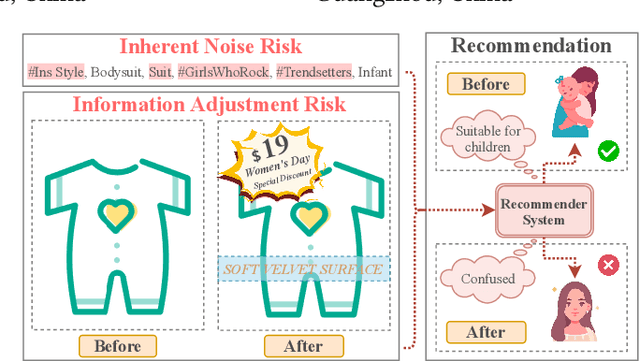
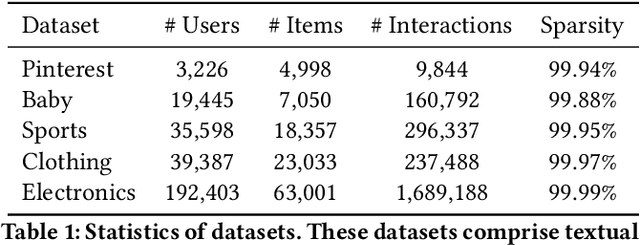
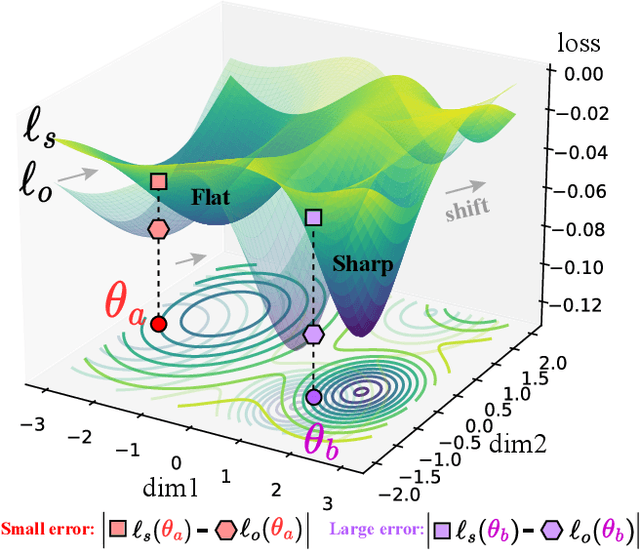
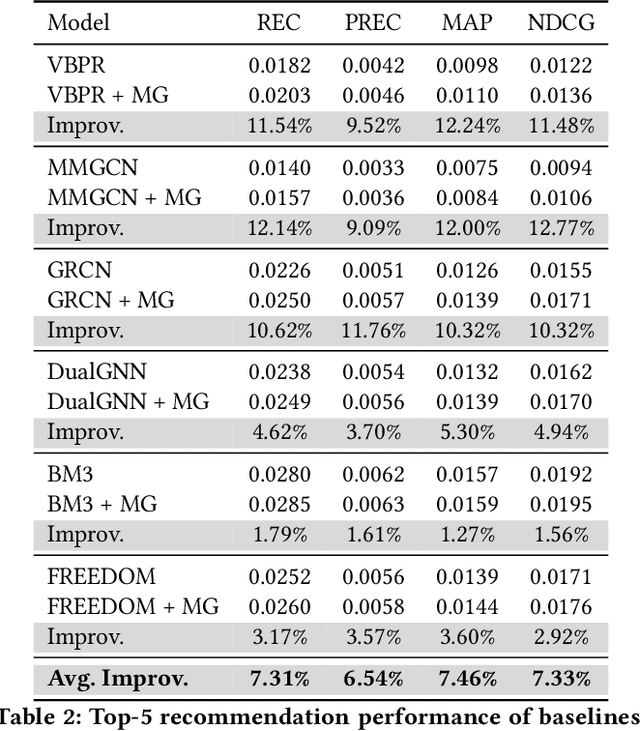
Abstract:Multimodal recommender systems utilize various types of information to model user preferences and item features, helping users discover items aligned with their interests. The integration of multimodal information mitigates the inherent challenges in recommender systems, e.g., the data sparsity problem and cold-start issues. However, it simultaneously magnifies certain risks from multimodal information inputs, such as information adjustment risk and inherent noise risk. These risks pose crucial challenges to the robustness of recommendation models. In this paper, we analyze multimodal recommender systems from the novel perspective of flat local minima and propose a concise yet effective gradient strategy called Mirror Gradient (MG). This strategy can implicitly enhance the model's robustness during the optimization process, mitigating instability risks arising from multimodal information inputs. We also provide strong theoretical evidence and conduct extensive empirical experiments to show the superiority of MG across various multimodal recommendation models and benchmarks. Furthermore, we find that the proposed MG can complement existing robust training methods and be easily extended to diverse advanced recommendation models, making it a promising new and fundamental paradigm for training multimodal recommender systems. The code is released at https://github.com/Qrange-group/Mirror-Gradient.
ADASR: An Adversarial Auto-Augmentation Framework for Hyperspectral and Multispectral Data Fusion
Oct 11, 2023Abstract:Deep learning-based hyperspectral image (HSI) super-resolution, which aims to generate high spatial resolution HSI (HR-HSI) by fusing hyperspectral image (HSI) and multispectral image (MSI) with deep neural networks (DNNs), has attracted lots of attention. However, neural networks require large amounts of training data, hindering their application in real-world scenarios. In this letter, we propose a novel adversarial automatic data augmentation framework ADASR that automatically optimizes and augments HSI-MSI sample pairs to enrich data diversity for HSI-MSI fusion. Our framework is sample-aware and optimizes an augmentor network and two downsampling networks jointly by adversarial learning so that we can learn more robust downsampling networks for training the upsampling network. Extensive experiments on two public classical hyperspectral datasets demonstrate the effectiveness of our ADASR compared to the state-of-the-art methods.
Understanding Self-attention Mechanism via Dynamical System Perspective
Aug 19, 2023Abstract:The self-attention mechanism (SAM) is widely used in various fields of artificial intelligence and has successfully boosted the performance of different models. However, current explanations of this mechanism are mainly based on intuitions and experiences, while there still lacks direct modeling for how the SAM helps performance. To mitigate this issue, in this paper, based on the dynamical system perspective of the residual neural network, we first show that the intrinsic stiffness phenomenon (SP) in the high-precision solution of ordinary differential equations (ODEs) also widely exists in high-performance neural networks (NN). Thus the ability of NN to measure SP at the feature level is necessary to obtain high performance and is an important factor in the difficulty of training NN. Similar to the adaptive step-size method which is effective in solving stiff ODEs, we show that the SAM is also a stiffness-aware step size adaptor that can enhance the model's representational ability to measure intrinsic SP by refining the estimation of stiffness information and generating adaptive attention values, which provides a new understanding about why and how the SAM can benefit the model performance. This novel perspective can also explain the lottery ticket hypothesis in SAM, design new quantitative metrics of representational ability, and inspire a new theoretic-inspired approach, StepNet. Extensive experiments on several popular benchmarks demonstrate that StepNet can extract fine-grained stiffness information and measure SP accurately, leading to significant improvements in various visual tasks.
SUR-adapter: Enhancing Text-to-Image Pre-trained Diffusion Models with Large Language Models
May 12, 2023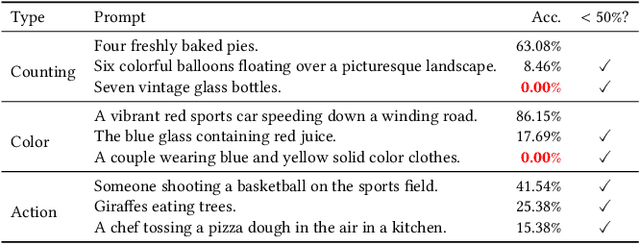
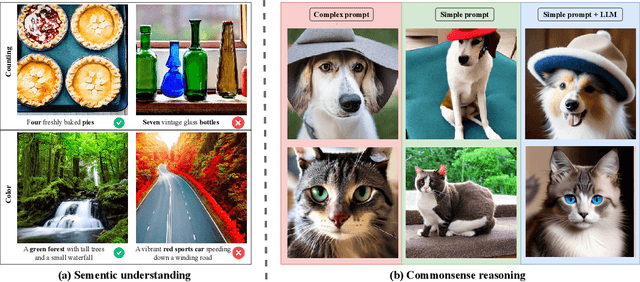
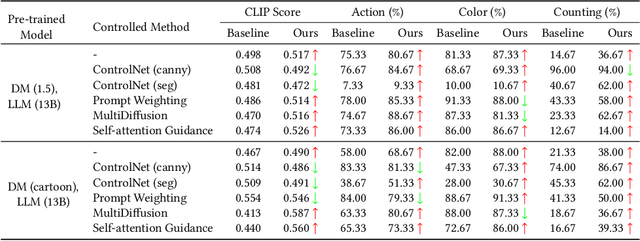
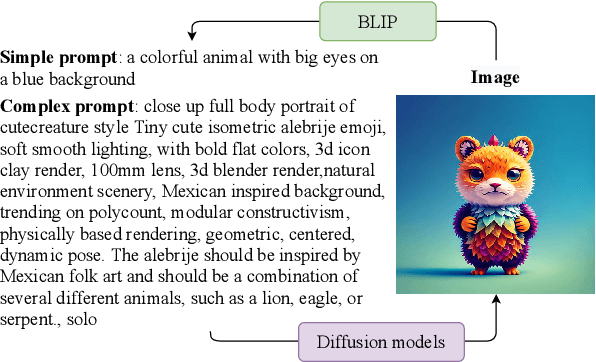
Abstract:Diffusion models, which have emerged to become popular text-to-image generation models, can produce high-quality and content-rich images guided by textual prompts. However, there are limitations to semantic understanding and commonsense reasoning in existing models when the input prompts are concise narrative, resulting in low-quality image generation. To improve the capacities for narrative prompts, we propose a simple-yet-effective parameter-efficient fine-tuning approach called the Semantic Understanding and Reasoning adapter (SUR-adapter) for pre-trained diffusion models. To reach this goal, we first collect and annotate a new dataset SURD which consists of more than 57,000 semantically corrected multi-modal samples. Each sample contains a simple narrative prompt, a complex keyword-based prompt, and a high-quality image. Then, we align the semantic representation of narrative prompts to the complex prompts and transfer knowledge of large language models (LLMs) to our SUR-adapter via knowledge distillation so that it can acquire the powerful semantic understanding and reasoning capabilities to build a high-quality textual semantic representation for text-to-image generation. We conduct experiments by integrating multiple LLMs and popular pre-trained diffusion models to show the effectiveness of our approach in enabling diffusion models to understand and reason concise natural language without image quality degradation. Our approach can make text-to-image diffusion models easier to use with better user experience, which demonstrates our approach has the potential for further advancing the development of user-friendly text-to-image generation models by bridging the semantic gap between simple narrative prompts and complex keyword-based prompts. The code is released at https://github.com/Qrange-group/SUR-adapter.
LSAS: Lightweight Sub-attention Strategy for Alleviating Attention Bias Problem
May 09, 2023



Abstract:In computer vision, the performance of deep neural networks (DNNs) is highly related to the feature extraction ability, i.e., the ability to recognize and focus on key pixel regions in an image. However, in this paper, we quantitatively and statistically illustrate that DNNs have a serious attention bias problem on many samples from some popular datasets: (1) Position bias: DNNs fully focus on label-independent regions; (2) Range bias: The focused regions from DNN are not completely contained in the ideal region. Moreover, we find that the existing self-attention modules can alleviate these biases to a certain extent, but the biases are still non-negligible. To further mitigate them, we propose a lightweight sub-attention strategy (LSAS), which utilizes high-order sub-attention modules to improve the original self-attention modules. The effectiveness of LSAS is demonstrated by extensive experiments on widely-used benchmark datasets and popular attention networks. We release our code to help other researchers to reproduce the results of LSAS~\footnote{https://github.com/Qrange-group/LSAS}.
 Add to Chrome
Add to Chrome Add to Firefox
Add to Firefox Add to Edge
Add to Edge